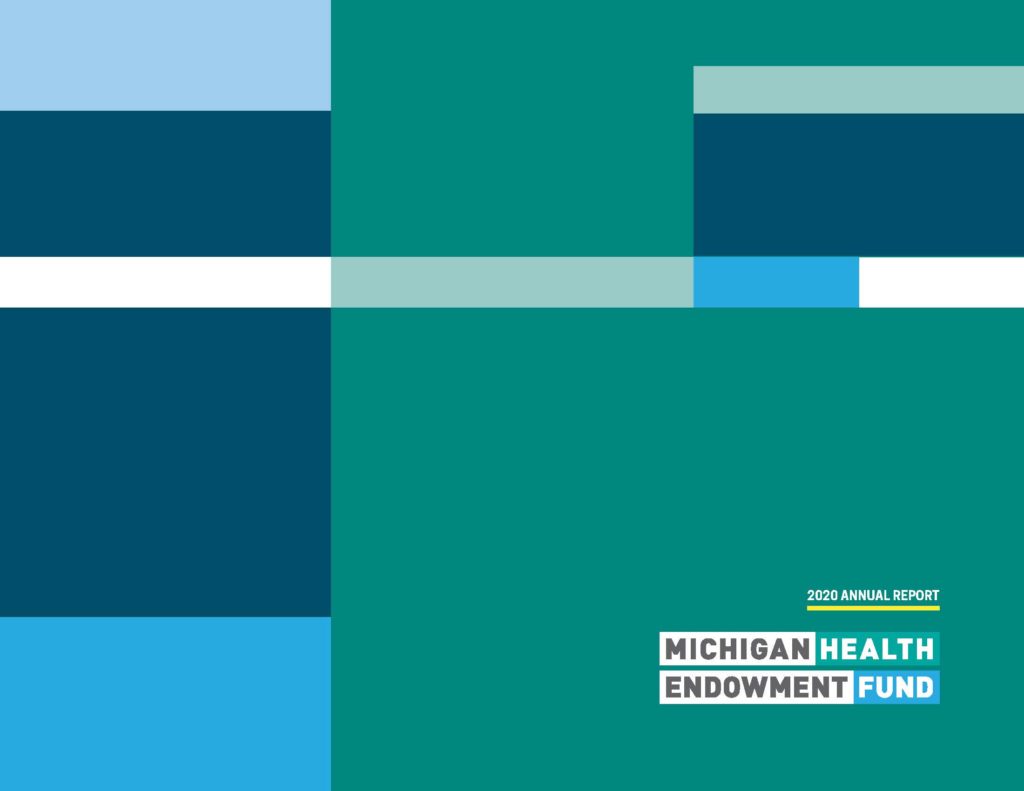
Our 2020 annual report reviews the ways the Health Fund continued to advance our mission during a historically challenging year. Read the introductory letter from Board Chair Susan Jandernoa below, and click here to view and download the full report [PDF].
Message from the Chair
 Challenges presented in 2020 shifted the work, priorities, and sense of “normal” for people across industries and issues. Like many organizations, the Health Fund moved our operations online early in the year. Next, we had to tackle the question of how our work should adapt—or stay the course—to best help the people of Michigan.
Challenges presented in 2020 shifted the work, priorities, and sense of “normal” for people across industries and issues. Like many organizations, the Health Fund moved our operations online early in the year. Next, we had to tackle the question of how our work should adapt—or stay the course—to best help the people of Michigan.
We knew that Michigan’s existing health challenges would persist or worsen during the pandemic: people experiencing behavioral health crises would face greater barriers to treatment; food insecurity would increase as families lost income and schools closed for months at a time; and Michigan’s older adults, already in need of increased support, would face the highest risk of serious illness or death from COVID-19.
In last year’s annual report, we shared our nascent efforts to strengthen Michigan’s health nonprofits, work that proved to be crucial in the quickly shifting and unpredictable funding landscape of 2020. As the pandemic developed, we continued to focus on our longtime priorities, supporting organizations across the state who in turn provided critical, reliable services to Michigan communities. We also added to our capacity-building offerings, expanding access to the One Michigan Catchafire portal and dedicating funding to capacity-building grants through our Community Health Impact program.
Still, COVID-19 presented emerging needs. One of the most urgent: in-person appointments were getting delayed or canceled, and healthcare providers had to quickly establish virtual capacities. In March, the Health Fund initiated a rapid response grant round, working with other funders and awarding nearly $3 million in immediate funding for telehealth projects.
While we’ve always supported the use of technology to improve service delivery, these grants expedited transitions that can sometimes take months or years to implement. As a result, more Michigan residents were able to see their doctors and access the care they needed during the pandemic. These grants also helped build a lasting infrastructure so providers can continue to broaden their use of technology in the future.
We awarded 203 grants totaling more than $36 million in 2020—more than we have ever awarded in a single year. It came as no surprise that our grant partners were our greatest strength throughout the year. Their years of experience, deep understanding of their communities’ strengths and needs, and collective ability to adapt were crucial during the most difficult months. Because of them, more Michigan families had access to necessary healthcare, nutritious food, and community support throughout the crisis.
The fight against COVID-19 didn’t end with 2020. Halfway through 2021, philanthropy and nonprofits alike are working to restart paused programs, use unexpected lessons to chart new public health strategies, and ensure everyone has access to a vaccine. Of course, the lessons of 2020 weren’t limited to those from COVID-19. Along with the rest of the country, Michigan organizations—including the Health Fund—are reflecting on and defining more equitable ways to approach all our work.Each year brings a fresh reminder that as funders, our success is not separate from that of our partners and ultimately the communities they serve. Those connections are at the heart of our latest strategic planning process, which began in 2020. In next year’s report, we look forward to bringing you that story, sharing how all we learned from 2020 has helped us plan for the next five years and beyond.
Wishing you health and wellness,

Susan Jandernoa
Board Chair

